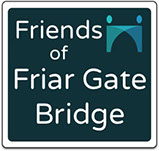The Britannia Ironworks
Andrew Handyside arrived on the Derby scene when he bought the Britannia Ironworks from Thomas Wright on June 21st 1847. These works had been established in 1818 by Weatherhead, Glover and Company in Duke Street on the West bank of the river Derwent, on what was then the northern edge of Derby. The firm specialised in cast iron window frames and columns, and highly decorative iron work such as the 1824 Gothic Prospect Tower in the gardens at Alton Towers.
The firm was taken over by Marshall, Baker and Wright in 1835, with Thomas Wright becoming the sole owner in 1843. During his five years of ownership he expanded the range of castings to include engineering products. Wright cashed in on the ‘Railway Mania’ sweeping the UK by including items for the rapidly growing railway industry. By this time he was producing large castings such as the footbridge over the Oxford Canal at Hawkesbury Junction.
Andrew Handyside
Andrew Handyside was born in Edinburgh on 25th July 1805, the son of Hugh Handyside and Margaret Baird. He spent most of his early adult life in Russia, working as a mechanical engineer for his uncle Charles Baird at his engineering works in St Petersburg. It is not known why he decided to come to Derby, but his brother William was well known for producing suspension bridges in St. Petersburg and this may have inspired him to try to do the same in an already well-established foundry in the UK. At the time Andrew Handyside was described by the Earl of Shrewsbury as ‘The most eminent iron founder of his day in Europe' - and the castings produced, now to be seen at Alton Towers, are universally admired for their taste and excellence. Handyside saw his opportunity.
He lived at ‘The Cedars’, 35 Ashbourne Road, Derby with his Polish wife Anastasia. He took over the foundry at just the right moment, and was able to use the experience gained in Russia to produce large engineering structures. His continental knowledge led to a very successful export business. He made great use of the Derby Canal to transport goods via the ‘Phoenix Branch’, which connected two parts of the River Derwent with the two sections of the canal.

Promoting the historical and architectural heritage of Friar Gate Bridge.
The foundry was extended to both sides of Duke Street by the time the Great Northern Railway arrived in Derby, and Handyside had his own sidings built to connect the foundry to the railway system. He built the elegant Friar Gate Bridge and also the bridge over the River Derwent for the new line. Now connected to the railway network, the business grew rapidly; in 1858 it had 270 employees and by 1907 it had 1200, the second biggest employer in Derby at the time. A larger site was built on the other side of the river in Fox Street/Clarke Street where all bridges and girders were manufactured. This site was connected to the rival Midland Railway system. The Andrew Handyside Company was now a very large operation with the Duke Street works covering 7.28 acres and the Fox Street/Clarke Street works 9.4 acres. It was responsible for creating railway station structures in Manchester, Liverpool, Middlesborough, Bradford and Glasgow; London’s Albert Bridge, Nottingham’s Trent Bridge and The National Agricultural Hall in London - now known as Olympia. Handyside’s nephew Alexander Buchanan became the Managing Director of the firm in 1873, the same year as it became a limited Company with Handyside as Chairman. After this, the company’s fortunes declined, and it finally closed down in 1910, shortly after supplying the structural ironwork for the new Rolls-Royce works in Nightingale Road.
Handyside was not just a business man; he represented the Bridge Ward as a Councillor, was on the Sewerage and Construction committee, was a church warden at St, John's Church in Bridge Street (whose window frames were cast by Weatherhead and Glover) and was a director of the Derby and Derbyshire Bank.
Andrew Handyside died on 9th June 1887 aged 81, and his wife Anastasia died on 16th November 1910 aged 87. Their grave is located in Uttoxeter New Road Cemetery, Derby (plot 1441).
To learn more about the vast range of items produced around the world by Andrew Handyside, visit the dedicated Andrew Handyside blog
Support the Friends of Friar Gate Bridge
Friends of Friar Gate Bridge is a Charitable Incorporated Organisation registered with the Charity Commission for England & Wales Number 1163174
© 2017 Friends of Friar Gate Bridge
Designed by Human Interface Publications